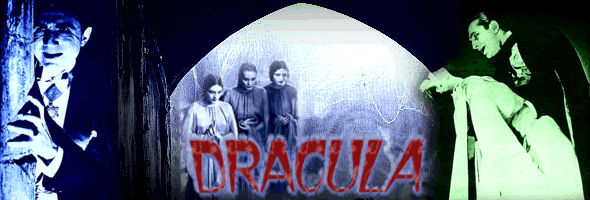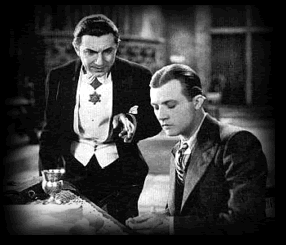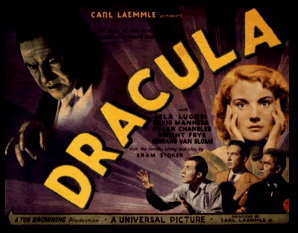
B&W, 1931, 75 mins. Directed by Tod Browning
Starring Bela Lugosi, Helen Chandler, David Manners, Dwight Frye, Edward Van Sloan / Produced by Carl Laemmle, Jr. / Cinematography by Karl Freund / Written by Garrett Fort
Format: DVD - Universal (MSRP $29.98)
In familiar fashion, the tale introduces Renfield (Dwight Frye), a real estate agent on his way to the castle of Count Dracula (Bela Lugosi), who welcomes his guest in a most peculiar fashion. Renfield deduces after some time that he should probably escape or lose his life, but by the time he returns home he's out of his mind and winds up in an asylum. However, the Count has purchased Carfax Abbey, a Unlike Francis Ford Coppolla's pseudo-operatic take on the novel, this Dracula remains romantic more through implication than plotting. Lugosi's piercing eyes and strange, elegant demeanor make him a truly imposing figure, one which he was clearly born to play. As magnetic as this vampire may be, the viewer is never allowed to forget what he truly is. While the majority of the film is extremely stagy (good as he is, Van Sloan has more than his share of awkward moments), the film still manages its share of dreamy, nightmarish moments, thanks primarily to Freund's graceful camerawork and a genuinely crazed performance from Frye as the crazed, insect-scarfing Renfield. Unlike James Whale's Frankenstein, which used powerful imagery to compensate for the relative quietness of its soundtrack, Dracula has always seemed terribly sluggish due to a complete absence of background music. Universal's DVD includes the option of playing a new Philip Glass score, performed by the Kronos Quartet; as revisionist as this may sound, this audio option actually helps the film's pacing in many respects. The hypnotic, austere quality of the music especially boosts the stagnant second half, though the tone of Glass' compositions is obviously an acquired taste and will not appeal to everywhere. Sadly, the image quality is the least impressive of the Universal monster releases. While their laserdisc of the "restored version" of the film, complete with some spooky background noises deemed too intense for 1931 viewers, looked much better than those old TV broadcasts, the DVD appears to be culled from a standard general circulation print. The quality still outclasses almost every film of this vintage, but compared to the astonishing restoration performed on Frankenstein, it's odd that Dracula would look so lackluster. At least the restored sound effects are still intact, so you can hear every squeaking rat and howling wolf as originally intended. As usual, the bonuses are top notch: David J. Skal contributes both a lively and educational commentary track (which compresses an amazing amount into 70 minutes) and a Dracula documentary which follows the same path as the other monster featurettes. The story's history and its path to the screen receive most of the attention, with occasional juicy vignettes thrown in to keep things interesting. A typically rough-looking theatrical trailer and the usual photo gallery (most of which will be familiar to Famous Monsters readers) round out the usual supplements. However, Universal has gone the extra mile of including the legendary alternate Spanish version, which was shot on the same sets but with different actors in Spanish. More protracted and "European" in tone, the Spanish version features much stronger visual fluidity but lacks the forceful personas of Lugosi and Van Sloan. In purely cinematic terms, though, the Spanish Dracula easily wins on a scene-for-scene basis. The impressive restored transfer is identical to the VHS release several years ago, with the same introduction by the film's female star, Lupita Tovar. An impressive package, this Dracula may not be perfect but certainly delivers on its promise for an admirably low price tag.
A legendary film whose reputation has arisen almost entirely thanks to its lead performance, Dracula may not bear much resemblance to the Bram Stoker source novel but nevertheless has rightfully earned its status in the horror classic pantheon. Much of the criticism of the film still holds true -- the Transylvania sequences are masterful, while the London ones can induce sleep -- but for sheer iconic value, Dracula has yet to be surpassed.
 decaying property in London, through which he insinuates himself into British society and begins to prey on the local denizens. The wily Dr. Van Helsing (Edward Van Sloan) unravels the mystery and realizes that the lovely Mina (Helen Chandler) is next on the Count's list; only by resorting to time-worn methods of battling evil can the doctor defeat this evil creature of the night.
decaying property in London, through which he insinuates himself into British society and begins to prey on the local denizens. The wily Dr. Van Helsing (Edward Van Sloan) unravels the mystery and realizes that the lovely Mina (Helen Chandler) is next on the Count's list; only by resorting to time-worn methods of battling evil can the doctor defeat this evil creature of the night.

